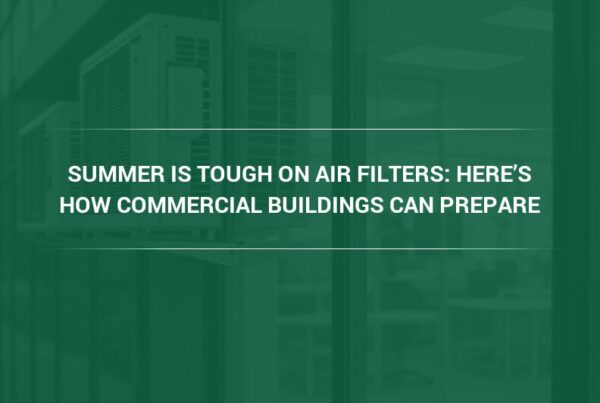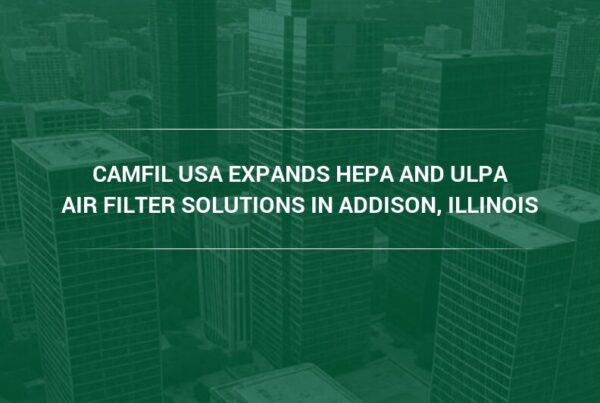Industrial air filters can affect the economy and the productivity of workers by protecting the health of workers from air pollution related diseases.
It’s clear that air pollution impacts people’s health and the environment. This is obvious to anyone who has been in a city with severe air pollution. Something else that is true, if less obvious, is that air pollution harms people’s productivity in addition to their health. People who work in office buildings in large cities, where air pollution levels are often quite high, are frequently less productive than their counterparts who work in clean air conditions.
Beyond this, air pollution causes a variety of illnesses. Respiratory and cardiovascular illnesses created by air pollution often lead to missed work days or even hospital visits. The world spends billions of dollars treating conditions associated with exposure to severe air pollution every year, constituting an even larger drain on the economy. How can air pollution be reduced to minimize the impact it has on the economy? What can office workers do to protect themselves against the threat of air pollution?
Commercial HVAC Air Filters Trap The Most Dangerous Air Pollutants
The average office worker in a city like Shanghai, Beijing, London or Los Angeles is exposed to a variety of harmful air pollutants on the way to and from work, and even while in the building where they work. The air in major metropolitan cities tends to be full of a variety of air pollutants, such as nitrogen oxide, sulfur dioxide, ozone, and particulate matter. Recent estimates predict that the high levels of particulate air pollution in Los Angeles cost the service-sector almost $375 million dollars over 90 days. What are the sources of the primary sources of the economically damaging air pollutants?
Nitrogen oxide comes from the interaction of nitrogen with the oxygen particles found in the air. When nitrogen is released by the combustion of fossil fuels, it combines with oxygen in the atmosphere to create nitric oxide, which then goes on to combine with more oxygen to create nitrogen dioxide. Though nitric oxide is not typically a major health hazard, in high enough concentrations it can be and nitrogen dioxide can be dangerous even at lower concentrations. Nitrogen oxide forms thick smog and acid rain, impacting visibility and damaging the environment.
Sulfur dioxide is similar to nitrogen oxide in that it comes from air mixing with byproducts from the combustion of fossil fuels. The discharged sulfur that is emitted from various industrial processes combines with oxygen in the air to create sulfur dioxide. Frequent sources of sulfur dioxide include industrial facilities (like those which process ore), locomotives, ships, and fossil fuel-based power plants.
While ozone protects us from the sun’s ultraviolet rays when it is in the upper atmosphere, in the lower atmosphere it is a toxic air pollutant. Ozone isn’t emitted directly into the air like some other air pollutants. Instead, it comes from the interaction of volatile organic compounds (VOCs) with sunlight and heat. There are many different sources of volatile organic compounds, including car exhaust, household chemicals like paints and cleaners, building equipment, printing shops and gasoline stations.
Particulate matter doesn’t refer to one pollutant in particular – it covers a wide variety of different tiny particles that are harmful to human health.
“When particles of air pollution are below a certain size, they are capable of entering into the human lungs and bloodstream, causing substantial damage. Particulate matter is usually grouped into three different categories, PM1, PM2.5 and PM10. These particles are smaller than 1-micron in size, smaller than 2.5-microns in size, and smaller than 10-microns in size respectively,” says Kevin Wood, Vice President of Marketing and Sales at Camfil USA commercial air filters. “Because particulate matter refers to so many different kinds of pollutants, they can have many different sources, but the combustion of fossil fuels at industrial facilities, power plants, and by motor vehicles are major contributors to PM air pollution.” (1)
Commercial Air Filtration Systems Help Prevent The Development of Diseases
Commercial air filtration systems should be used within an office building to protect the health, and the productivity, of workers in said buildings. Exposure to the various air pollutants can cause a variety of health problems such as irritation of the eyes, nose, and throat. Long-term exposure to air pollutants can cause more severe afflictions such as asthma, chronic obstructive pulmonary disorder, and lung cancer. Air filters can also reduce infectious cough and sneeze droplets that transfer colds and the flu.
Exposure to nitrogen oxides can cause a number of different lung problems, impacting a person’s ability to breathe. They can cause or aggravate respiratory conditions like bronchitis and emphysema, and exacerbate previous existing heart conditions like chronic obstructive pulmonary disorder. Exposure to nitrogen oxide is also correlated with the exacerbation of asthma.
Sulfur dioxide primarily damages the cardiovascular system, causing various respiratory illnesses like asthma and emphysema. Sulfur dioxide can aggravate existing heart diseases and lead to issues like chronic obstructive pulmonary disorder, much like nitrogen oxides.
Ozone and other kinds of photochemical smog can irritate the lungs, and lead to headaches, nausea, chest discomfort, and the exacerbation of asthma. Continuous exposure to high concentrations of ozone can permanently impair lung function and may make a person’s lungs more vulnerable to infection.
Particulate matter can lead to asthma attacks, visits to the emergency room, and even premature death. The small particles can cause a number of different health problems such as stroke, heart attack, arrhythmia, pneumonia, and lung cancer.
High Efficiency Air Filtration Units Can Keep The Productivity of Workers High
Air pollution can harm the health and productivity of office workers, and increase the need for high efficiency air filtration units in a number of ways. It can decrease the overall level of productivity of workers, making them think and react more slowly, distract them from their work with coughing or wheezing, and necessitate sick days or trips to the hospital.
“One study found that as the air pollution index increased by 10% in the concentration of air pollution, the number of calls handled by a call center fell by about 0.35% per day,” says Wood at Camfil USA commercial air filters. “This means that overall workers were about 6% more productive on days with low air pollution, compared to when air pollution was high. A separate analysis found that if China could reduce its air pollution index by 10 points overall, worker productivity would go up around $2.2 billion every year.” (2)
These findings are neatly explained when you consider the activity that occurs in office buildings situated in polluted cities accounts for around 64.5% of global GDP. Separate studies have resulted in findings that corroborate the results of this research project. When workers were tested in two different environments, those who were tested in the “green conditions” performed approximately 61% better at a variety of cognitive tasks than those who were tested in the normal (polluted) office conditions.
Researchers also found that workers who work in green-certified office buildings have approximately 30% fewer headaches and perform around 25% better on cognitive tasks than their counterparts who work in non-green certified buildings. While this study tracked the effects of indoor air pollution rather than outdoor air pollution, the pollutants that impact people’s health are usually quite similar for both indoor and outdoor conditions.
Research suggests that spending approximately $40 per person on indoor air quality every year can lead to a $6500 increase in the productivity of employees, negating the need for employees to take as many sick days due to ailments caused by air pollution.
Portable Air Purifiers Can Be Used Alongside Filters in HVAC Systems
Managers of office buildings can protect the productivity and health of their workers by using portable air purifiers. Portable air purifiers give an extra level of protection to a building over its regular HVAC system. Portable air purifiers can remove the toxic air pollutants from the air within a building that may infiltrate in from outside the building, as well as from indoor sources of air pollutants.
Any portable air purifier purchased should include a replaceable HEPA air filter. HEPA filters are High-Efficiency Particulate Air filters, and they are capable of removing up to 99.97% of pollutants as small as 0.3 microns across. Electrostatic precipitators and ozone generators should be avoided as these devices can emit harmful ozone as a by-product and are less effective than purifiers that use HEPA filters.
High Efficiency Air Filtration and Ventilation Can’t Combat Ambient Air Pollution
High efficiency air filtration and ventilation are capable of defending the health and productivity of office workers, as long as those air pollutants are indoors. Air filtration is of minimal help against the ambient air pollution that harms workers on their way to and from work. For these reasons, policies to reduce levels of ambient air pollution should be enforced. The United States EPA suggests that economic and engineering solutions should be used together to curb air pollution.
Economic air pollution reduction policies include the creation and enforcement of limits for emissions from vehicles and industrial facilities. Vehicle emissions limits are important as motor vehicles are one of the primary sources of air pollution, and the creation of these limits causes automobile manufacturers to invest in the creation of emissions-reducing devices like catalytic converters. Emissions limits are also important for power plants and industrial facilities, and punitive measures can be augmented with cap and trade programs to encourage companies to voluntarily lower their emissions.
“Engineering-based solutions include the creation of devices to capture and reduce emissions from power plants, industrial plants, and motor vehicles,” says Wood. “Wet scrubbers, electrostatic precipitators, absorbers, and filters can all be used to reduce the overall amount of air pollutants released by a specific facility. Switching to cleaner forms of energy generation, such as solar energy, wind energy or hydro energy are highly effective ways of reducing air pollution, as is powering electric vehicles with the energy generated from clean energy sources. ” (3)
Camfil USA air filters can ensure that your productivity is always at maximum by providing you with the most effective commercial and industrial air filters around, so contact Camfil USA commercial air filters today.
Lynne Laake
Camfil USA Air Filters
T: 888.599.6620
E:Lynne.Laake@camfil.com
F: Friend Camfil USA on Facebook
Sources:



